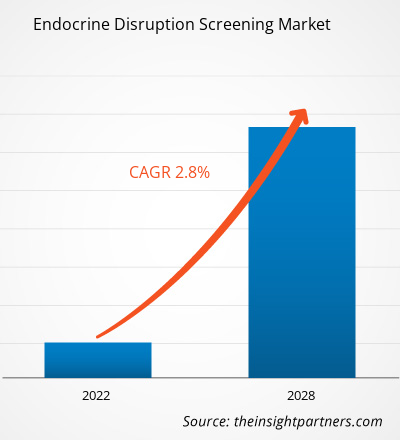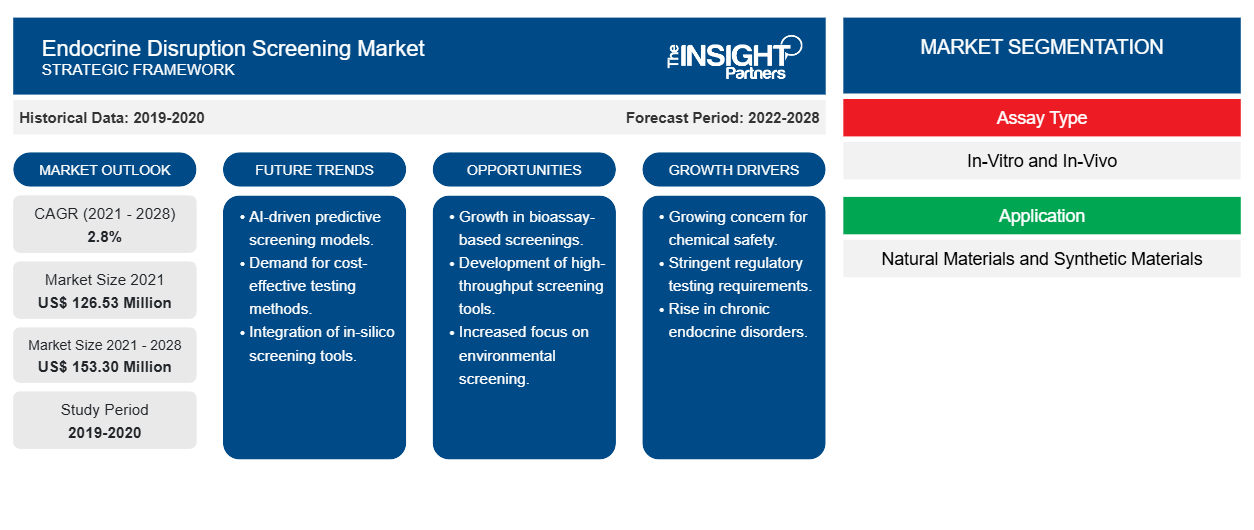Se proyecta que el mercado de detección de alteraciones endocrinas alcance los 153,30 millones de dólares en 2028, desde los 126,53 millones de dólares en 2021; se espera que crezca a una CAGR del 2,8% entre 2021 y 2028.
Muchos productos químicos, tanto naturales como artificiales, tienen el potencial de imitar o interferir con el sistema endocrino, que regula las hormonas del cuerpo. Estos productos químicos, conocidos como disruptores endocrinos, se han relacionado con trastornos del desarrollo, reproductivos, cerebrales, inmunológicos y de otro tipo. Los disruptores endocrinos pueden estar presentes en una variedad de artículos comunes, como algunas botellas y recipientes de plástico, revestimientos metálicos para latas de alimentos, detergentes, retardantes de llama, alimentos, juguetes, cosméticos y pesticidas. Los pesticidas, los productos químicos y las toxinas ambientales se examinan utilizando un método de dos niveles para determinar su posible efecto sobre los sistemas de estrógeno, andrógeno y hormona tiroidea mediante el examen de disruptores endocrinos.
El crecimiento del mercado de detección de alteraciones endocrinas se atribuye a la creciente investigación en el sector de la biotecnología y a la creciente prevalencia de trastornos endocrinos. Sin embargo, el alto costo de la tecnología de detección obstaculiza el crecimiento del mercado.
Personalice este informe según sus necesidades
Obtendrá personalización en cualquier informe, sin cargo, incluidas partes de este informe o análisis a nivel de país, paquete de datos de Excel, así como también grandes ofertas y descuentos para empresas emergentes y universidades.
-
Obtenga las principales tendencias clave del mercado de este informe.Esta muestra GRATUITA incluirá análisis de datos, desde tendencias del mercado hasta estimaciones y pronósticos.
Perspectivas de mercado
La creciente prevalencia de trastornos endocrinos impulsa el mercado de detección de alteraciones endocrinas
La acromegalia (sobreproducción de la hormona del crecimiento), la obesidad, el síndrome metabólico, la alteración de la glucosa en ayunas, la alteración de la tolerancia a la glucosa, la osteoporosis, la osteopenia, la hipovitaminosis D leve a moderada, la disfunción eréctil, la dislipidemia y la tiroiditis se encuentran entre los trastornos endocrinos que tienen una prevalencia colectiva de al menos el 5% entre los adultos en los EE. UU. De estas afecciones, los hombres tienen la mayor incidencia de disfunción eréctil, mientras que las mujeres tienen la mayor incidencia de osteopenia/osteoporosis. La diabetes mellitus en niños y el adenoma hipofisario son las afecciones menos comunes, que afectan a menos del 1% de la población estadounidense. El carcinoma adrenocortical, el feocromocitoma y los adenomas hipofisarios son las afecciones con la incidencia más baja. El hiperparatiroidismo y los trastornos tiroideos son más comunes en las mujeres. La diabetes mellitus es más prevalente entre las minorías étnicas. Las enfermedades endocrinas y metabólicas se encuentran entre las dolencias humanas modernas más comunes, particularmente en los EE. UU. y otros países que implementan amplios programas de nutrición y detección para individuos de alto riesgo. Los trastornos endocrinos como el hiperparatiroidismo, el hipogonadismo primario y secundario, la deficiencia de GH y el hipotiroidismo pueden dar lugar a otros trastornos, como la enfermedad ósea metabólica y la diabetes mellitus. Por ello, la creciente prevalencia e incidencia de dichas afecciones impulsa la demanda de productos de detección de alteraciones endocrinas.
Información basada en el tipo de ensayo
El mercado de detección de alteraciones endocrinas, por tipo de ensayo, se divide en in vitro e in vivo. El segmento in vitro lideró el mercado en 2021, contribuyendo con una participación de mercado del 64,45 %, y se espera que mantenga su dominio durante el período de pronóstico para representar una participación de mercado del 65,73 % de los ingresos generales generados en 2028.
Perspectivas basadas en aplicaciones
Por aplicación, el mercado de detección de alteraciones endocrinas se divide en materiales naturales y materiales sintéticos. En 2021, el segmento de materiales naturales tuvo una mayor participación en el mercado. Además, se espera que el mercado del mismo segmento crezca a una CAGR más rápida del 3,1 % durante 2021-2028.
Fuente de información basada en residuos
El mercado de detección de alteraciones endocrinas, por fuente de desechos, se segmenta en incineración y vertederos, escorrentías agrícolas, efluentes industriales y municipales, efluentes de plantas de pulpa, productos de consumo y otros. En 2021, el segmento de incineración y vertederos tuvo la mayor participación del mercado. Además, se espera que el mercado para el mismo segmento crezca a la CAGR más rápida del 3,5% durante 2021-2028.
Perspectivas basadas en métodos
El mercado de detección de alteraciones endocrinas, por método, se segmenta en transactivación del receptor de estrógeno (ER), transactivación del receptor de andrógeno (AR), modulación del receptor de andrógeno (AR), unión del receptor de estrógeno alfa (ER), unión del receptor de estrógeno beta (ER), unión del receptor de andrógeno (AR), esteroidogénesis, ensayo de aromatasa y otros. En 2021, el segmento de transactivación del receptor de estrógeno (ER) tuvo la mayor participación del mercado. Además, se espera que el mercado del mismo segmento crezca a la CAGR más rápida del 3,7% entre 2021 y 2028.
Información basada en el usuario final
El mercado de detección de alteraciones endocrinas, en función del uso final, está segmentado en empresas farmacéuticas y biofarmacéuticas, empresas de cosméticos y productos para el hogar, industria alimentaria e industria química. En 2021, el segmento de empresas farmacéuticas y biofarmacéuticas tuvo la mayor participación del mercado. Además, se espera que el mercado del mismo segmento crezca a la tasa compuesta anual más rápida del 3,3 % durante 2021-2028.
Los lanzamientos y aprobaciones de productos son estrategias que las empresas suelen adoptar para ampliar su presencia global y sus carteras de productos. Además, los actores del mercado de detección de trastornos endocrinos se centran en la estrategia de asociación para ampliar su clientela, lo que, a su vez, les permite mantener su marca en todo el mundo.
Perspectivas regionales del mercado de detección de alteraciones endocrinas
Los analistas de Insight Partners explicaron en detalle las tendencias y los factores regionales que influyen en el mercado de detección de alteraciones endocrinas durante el período de pronóstico. Esta sección también analiza los segmentos y la geografía del mercado de detección de alteraciones endocrinas en América del Norte, Europa, Asia Pacífico, Oriente Medio y África, y América del Sur y Central.

- Obtenga datos regionales específicos para el mercado de detección de alteraciones endocrinas
Alcance del informe de mercado sobre detección de alteraciones endocrinas
| Atributo del informe | Detalles |
|---|---|
| Tamaño del mercado en 2021 | US$ 126,53 millones |
| Tamaño del mercado en 2028 | US$ 153,30 millones |
| CAGR global (2021-2028) | 2,8% |
| Datos históricos | 2019-2020 |
| Período de pronóstico | 2022-2028 |
| Segmentos cubiertos |
Por tipo de ensayo
|
| Regiones y países cubiertos |
América del norte
|
| Líderes del mercado y perfiles de empresas clave |
|
Densidad de actores del mercado: comprensión de su impacto en la dinámica empresarial
El mercado de detección de alteraciones endocrinas está creciendo rápidamente, impulsado por la creciente demanda de los usuarios finales debido a factores como la evolución de las preferencias de los consumidores, los avances tecnológicos y una mayor conciencia de los beneficios del producto. A medida que aumenta la demanda, las empresas amplían sus ofertas, innovan para satisfacer las necesidades de los consumidores y aprovechan las tendencias emergentes, lo que impulsa aún más el crecimiento del mercado.
La densidad de actores del mercado se refiere a la distribución de las empresas o firmas que operan dentro de un mercado o industria en particular. Indica cuántos competidores (actores del mercado) están presentes en un espacio de mercado determinado en relación con su tamaño o valor total de mercado.
Las principales empresas que operan en el mercado de detección de alteraciones endocrinas son:
- BIOARREGLAS CREATIVAS
- XENOMETRIX AG
- Río Charles
- EUROFINS CIENTÍFICO
- Herreros
Descargo de responsabilidad : Las empresas enumeradas anteriormente no están clasificadas en ningún orden particular.

- Obtenga una descripción general de los principales actores clave del mercado de detección de alteraciones endocrinas
El informe segmenta el mercado de detección de alteraciones endocrinas de la siguiente manera
Mercado de detección de alteraciones endocrinas: por tipo de ensayo
- In vitro
- In vivo
Mercado de detección de alteraciones endocrinas: por aplicación
- Materiales naturales
- Materiales sintéticos
Mercado de detección de alteraciones endocrinas: por fuentes de desechos
- Incineración y vertederos
- Escorrentía agrícola
- Efluentes industriales y municipales
- Efluentes de plantas de celulosa
- Productos de consumo
- Otros
Mercado de detección de alteraciones endocrinas: por método
- Transactivación del receptor de estrógeno (RE)
- Transactivación del receptor de andrógenos (AR)
- Modulación del receptor de andrógenos (AR)
- Unión al receptor de estrógeno alfa (ER-alfa)
- Unión al receptor beta de estrógeno (ER-beta)
- Unión del receptor de andrógenos (AR)
- Esteroidogénesis
- Ensayo de aromatasa
- Otros
Mercado de detección de alteraciones endocrinas: por usuario final
- Empresas farmacéuticas y biofarmacéuticas
- Industria química
- Industria alimentaria
- Empresas de productos cosméticos y para el hogar
Mercado de detección de alteraciones endocrinas por geografía
-
América del norte
- A NOSOTROS
- Canadá
- México
-
Europa
- Reino Unido
- Alemania
- Francia
- Italia
- España
- Resto de Europa
-
Asia Pacífico
- Porcelana
- Japón
- India
- Australia
- Corea del Sur
- Resto de Asia Pacífico
-
Oriente Medio y África
- Emiratos Árabes Unidos
- Arabia Saudita
- Sudáfrica
- Resto de Oriente Medio y África
-
América del Sur y Central
- Brasil
- Argentina
- Resto de América del Sur y Central
Perfiles de empresas
- BIOARREGLAS CREATIVAS
- XENOMETRIX AG
- LABORATORIOS CHARLES RIVER, INC.
- EUROFINS SCIENTIFIC Ltd.
- Herreros
- SGS SA
- JRF GLOBAL
- NUTRICIENCIAS DE MÉRIEUX
- ALFA ANALÍTICA INC.
- Análisis histórico (2 años), año base, pronóstico (7 años) con CAGR
- Análisis PEST y FODA
- Tamaño del mercado, valor/volumen: global, regional y nacional
- Industria y panorama competitivo
- Conjunto de datos de Excel
Informes recientes
Testimonios
Razón para comprar
- Toma de decisiones informada
- Comprensión de la dinámica del mercado
- Análisis competitivo
- Información sobre clientes
- Pronósticos del mercado
- Mitigación de riesgos
- Planificación estratégica
- Justificación de la inversión
- Identificación de mercados emergentes
- Mejora de las estrategias de marketing
- Impulso de la eficiencia operativa
- Alineación con las tendencias regulatorias























 Obtenga una muestra gratuita para - Mercado de detección de alteraciones endocrinas
Obtenga una muestra gratuita para - Mercado de detección de alteraciones endocrinas